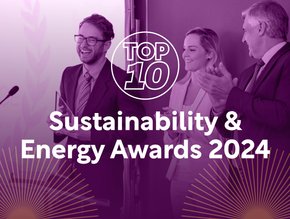Top 10: Leading Carbon Capture Companies

What once seemed like a pipeline dream is slowly but surely turning into a sustainable reality - significant investments by major carbon capture companies have resulted in cheaper technologies, offering a promising future for both companies and technology in carbon capture projects. This presents new opportunities to tackle climate change by reducing greenhouse gas emissions, which is crucial in achieving net-zero goals.
Energy Digital Magazine takes a look at the top 10 carbon capture companies, by the amount of carbon captured per year.
10. Global Thermostat
Carbon capture per year (in tonnes of CO2): 4,000
Founded in 2010, Global Thermostat's DAC technology uses a patented process called the "Carbon dioxide Removal Assembly" (CDRA), which involves capturing CO2 using a proprietary adsorbent material that is regenerated by a low-grade heat source. The CO2 is then compressed and can be utilised in various applications, such as in enhanced oil recovery, cement production, or as a feedstock for the production of renewable fuels.
Global Thermostat has partnerships with various organisations and companies, including ExxonMobil, which has invested in the company and is exploring the use of its DAC technology for carbon capture and utilisation.
9. Climeworks
Carbon capture per year (in tonnes of CO2): 4,000
Climeworks is a Swiss company that specializes in direct air capture (DAC) technology, which involves extracting carbon dioxide directly from the atmosphere. Founded in 2009 by Christoph Gebald and Jan Wurzbacher, the company has become a prominent player in the carbon capture industry.
Climeworks has several DAC facilities around the world, including in Switzerland, Italy, and Iceland, and it has partnerships with various organisations and companies, such as Audi, Microsoft, and Swiss Re, to advance the development and deployment of carbon capture technology.
8. CO2 Solutions by SAIPEM
Carbon capture per year (in tonnes of CO2): 11,000
CO2 Solutions is a carbon capture technology developed by the Italian engineering and energy services company Saipem, in 1997. The technology uses an enzyme-based approach to capture carbon dioxide from industrial emissions, such as those from power plants, cement factories, and steel mills.
One of the key advantages of the CO2 Solutions technology is its ability to capture carbon dioxide at a lower cost than traditional carbon capture techniques, such as amine-based solvents. Additionally, the use of enzymes allows for a more sustainable and environmentally friendly process, as it does not require toxic chemicals or produce harmful byproducts.
7. LanzaTech
Carbon capture per year (in tonnes of CO2): 150,000
LanzaTech is a biotechnology company that specialises in developing and commercialising carbon capture and utilization (CCU) technology. The company was founded in New Zealand in 2005 by Dr. Sean Simpson and has since expanded to locations around the world, including the United States, China, India, and Europe.
LanzaTech's CCU technology involves capturing waste gases, such as those produced by industrial processes, and converting them into valuable chemicals and fuels using microorganisms. In addition to its CCU technology, LanzaTech is also developing other technologies to address climate change, such as a process to convert carbon dioxide into new materials, such as polymers and plastics.
6. Carbon Clean
Carbon capture in 2022 (in tonnes of CO2): 335,745
Carbon Clean Solutions Limited, also known as Carbon Clean, is a company that provides low-cost carbon capture technology to help reduce carbon emissions. The company was founded in 2009 and is headquartered in London, UK, with additional offices in India and the United States.
Carbon Clean's technology uses a proprietary solvent to capture carbon dioxide emissions from industrial processes, such as power plants and cement factories. The captured CO2 is then separated from the solvent and compressed into a pure form, which can be transported and stored for reuse or permanently sequestered underground.
5. Aker Carbon Capture
Carbon capture per year (in tonnes of CO2): 400,000
Aker Carbon Capture, a subsidiary of Aker Solutions, is a leading player in the carbon sequestration industry. The company went public in 2020, listing on the Oslo Stock Exchange and currently has a market cap of $750.65 million.
Aker Carbon Capture utilises its own proprietary carbon capture technology to capture CO2 from waste flue gases generated by various industries, such as oil refineries and cement plants. The company's modular solutions are designed for easy transport and installation, and it also provides offshore and integrated solutions.
4. Carbon Engineering
Carbon capture per year (in tonnes of CO2): 1 million
Carbon Engineering has garnered substantial funding amounting to $110 million and has established itself as a prominent player in the industry. Its unique liquid DAC technique, which employs a potassium hydroxide solution to trap CO2, has garnered confidence and investments from renowned names such as Chevron, Occidental, Airbus, Air Canada, and Bill Gates, among others.
Carbon Engineering has licensed its DAC technology to 1PointFive with the objective of constructing a megaton-scale plant in the Permian Basin in the U.S. This plant will have the capacity to capture 1 million tons of CO2 annually starting in 2024.
3. Quest Carbon Capture & Storage (SHELL)
Carbon capture per year (in tonnes of CO2): 1.2 million
Quest Carbon Capture and Storage is a project developed and operated by Shell Canada, which involves capturing and storing carbon dioxide (CO2) emissions from a bitumen upgrader plant in Alberta, Canada. The project was completed in 2015 and is one of the largest carbon capture and storage (CCS) projects in the world.
The Quest project uses a process called post-combustion capture to capture up to 1 million metric tons of CO2 emissions per year from the Scotford Upgrader, a facility that processes bitumen from the oil sands. The captured CO2 is then transported via pipeline and stored deep underground in a saline reservoir, where it is expected to remain trapped for thousands of years.

2. CarbonFree
Carbon capture per year (in tonnes of CO2): 800 million
CarbonFree is a company that employs patented technologies to capture carbon dioxide emissions from stationary point source emitters and convert them into carbon-negative chemicals. The company's innovative products, SkyCycle™ and SkyMine®, use this captured CO2 to create useful chemicals like sodium bicarbonate, precipitated calcium carbonate, and hydrochloric acid.
CarbonFree's modular and scalable technology can be used on-site, eliminating the need for expensive infrastructure to transport and store the captured CO2. The company's goal is to help all industrial manufacturing plants reduce their carbon emissions and create sustainable, environmentally-friendly products.
1. CarbFix
Carbon capture per year (in tonnes of CO2): 1 billion/lifetime
Established in 2006, Carbfix is an Icelandic company that specialises in carbon capture and storage (CCS) technology. The company's unique approach to CCS involves injecting captured carbon dioxide (CO2) into basaltic rock formations deep beneath the Earth's surface.
Carbfix's process involves dissolving CO2 in water and then injecting the resulting solution into the basaltic rock formations. Once underground, the dissolved CO2 reacts with the minerals in the rock and solidifies into a mineral form, effectively removing it from the atmosphere and locking it away for thousands of years.
Carbfix's approach is based on accelerating a natural process in which dissolved CO2 interacts with reactive rock formations to create stable carbonate minerals. This creates a safe and permanent storage solution for carbon dioxide, which helps to reduce its impact on the environment.






